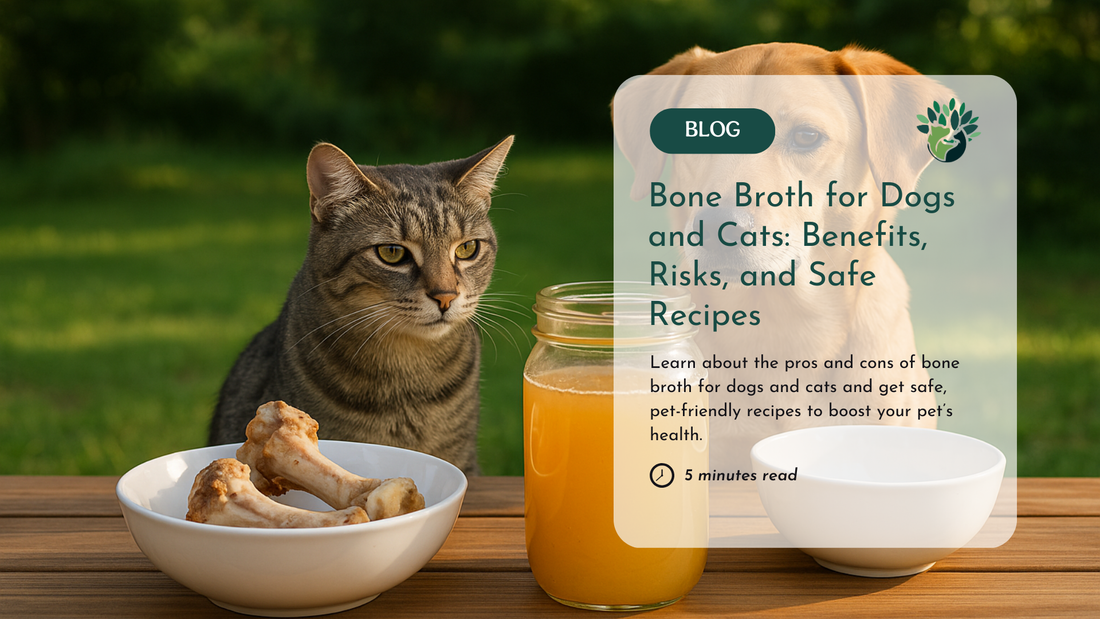Bone broth is a nutrient-dense liquid made by simmering animal bones (often beef, chicken, or turkey) along with connective tissue, vegetables, and herbs for an extended period. When prepared properly, it’s rich in amino acids, minerals, and compounds like collagen and glucosamine.
Should You Give Your Dog Bone Broth? Benefits vs. Risks
Bone broth can be a fantastic addition to your dog's diet, but it comes with a few caveats. Let’s break it down.
First, the benefits: Bone broth is rich in minerals, collagen, glucosamine, and chondroitin, which are excellent for joint health, gut support, and overall nourishment. It’s especially helpful for pets recovering from illness or with digestive issues because it’s easy to digest and provides nutrients in a form that requires minimal effort for the body to absorb. Think of it as the pet equivalent of a comforting bowl of chicken soup when you’re under the weather .
Now, the concerns: Bones are natural storage sites for heavy metals like lead and cadmium, especially in animals raised in less-than-ideal conditions. When you simmer bones for long periods, you’re not only extracting the good stuff but also potentially leaching out these heavy metals. In fact, a study published in Medical Hypotheses found that chicken bone broth contained significantly higher levels of lead than the water it was cooked in—up to 9.5 μg/L compared with just 0.89 μg/L in the control water (Monro et al., 2013). This suggests that bone broth can indeed be a source of heavy metal exposure. Additionally, bone broth can trigger histamine release in pets with sensitive guts or allergies, which might worsen symptoms like itchy skin or digestive upset.
For these reasons, I often recommend starting with a basic stock or stew made from bones, which you simmer for a shorter time—say, 2-4 hours instead of the 24-48 hours typical for bone broth. This approach still provides plenty of nutrients without extracting as many heavy metals or triggering histamine responses. A controlled study found that longer cooking times (over 8 hours) significantly increased extraction of essential minerals like calcium and magnesium into the broth, compared to shorter simmer times (e.g., 0.5 to 4 hours
Bone Broth for Cats: Is It the Same as for Dogs?
Bone broth can absolutely be beneficial for cats too, but there are a few nuances to consider since cats have unique dietary needs and sensitivities compared to dogs. Let’s dive into it.
For cats, bone broth offers similar benefits as it does for dogs, it's rich in collagen, glucosamine, chondroitin, and minerals, which can support joint health, gut healing, and hydration. Cats, being obligate carnivores, often thrive on nutrient-dense, animal-based foods, and bone broth can be a great way to supplement their diet, especially if they’re dealing with illness, poor appetite, or dehydration. It’s like giving them a warm, nourishing hug in a bowl!
Key Consideration
-
Cats are much smaller than dogs, so you’ll want to start with a very small amount, about ½ teaspoon per meal, and gradually increase to no more than 1-2 teaspoons per meal. Cats can be sensitive to dietary changes, so introducing bone broth slowly helps avoid any digestive upset .
-
Just like with dogs, bone broth can sometimes trigger histamine reactions in cats, especially if they have allergies or gut sensitivities. If your cat has a history of itchy skin, vomiting, or diarrhea, you might want to opt for a shorter-cooked stock instead of a full bone broth. Stocks cooked for 2-4 hours extract many of the same nutrients without as much risk of histamine release .
-
Cats are more sensitive to toxins than dogs, so it’s even more critical to use high-quality, organic, pasture-raised bones to minimize the risk of heavy metal contamination. Chicken bones, duck bones, or small fish bones are excellent choices because they’re rich in collagen and easier to source organically .
-
Cats can be notoriously picky eaters. If your cat turns up their nose at plain bone broth, you can try adding a small amount of cooked chicken or fish to the broth to make it more enticing. Just be sure to avoid adding any onions, garlic, or seasonings, as these are toxic to cats .
-
Bone broth is particularly helpful for cats who don’t drink enough water, which is a common issue. Adding a teaspoon of broth to their regular meals or offering it as a standalone treat can encourage hydration, especially for cats on dry food diets .
To make bone broth for your cat, follow the same basic recipe as for dogs: simmer high-quality bones with water and a splash of apple cider vinegar for 12-24 hours. Strain it well to remove all bone fragments, as even tiny pieces can be a choking hazard or cause internal injury for cats. Store it in the fridge for up to 5 days or freeze it in small portions for up to 6 months
Bone Broth Recipe for Dogs and Cats
If you’re ready to make bone broth, here’s how to do it safely:
|
Recommendations in Making Bone Broth for Dogs and Cats
- Apple cider vinegar is essential in the recipe to help extract nutrients from bones.
- Slow cooking for 24 hours is necessary to maximize nutrient extraction.
- Monitor pets for any adverse reactions, especially if there is a history of food sensitivities.
- Use the broth as a supplement, not a complete diet replacement.
- Frozen broth portions can be used conveniently as needed.
If your pet has a history of allergies or gut sensitivities, proceed cautiously. In some cases, a simple stock or stew might be a better option than a full bone broth. And remember, your pet’s best health starts in the bowl, so always prioritize high-quality ingredients and balanced nutrition
Store-Bought vs. Homemade Bone Broth: Which Is Better for Pets?
While homemade bone broth gives you full control over the ingredients, store-bought versions can be convenient, but not all are safe for pets. Commercial broths may contain onions, garlic, salt, or artificial flavors, which can be toxic to dogs and cats. Even “pet-safe” broths may include preservatives that upset sensitive stomachs.
Homemade Bone Broth:
✅ Full ingredient control
✅ No additives or excess sodium
✅ More cost-effective in the long run
❌ Requires time and planning
Store-Bought Bone Broth:
✅ Convenient and ready-to-use
✅ Pet-specific brands exist (formulated without harmful ingredients)
❌ Must carefully read labels, avoid products with onions, garlic, or seasonings
❌ Often more expensive per serving
👉 If you opt for store-bought, always choose pet-formulated bone broth (usually found in pet stores or holistic vet clinics) rather than broths intended for humans.
Final Thoughts
Bone broth can be a wonderful, nutrient-packed supplement for both dogs and cats when it’s made and served safely. It supports joint health, digestion, hydration, and recovery, but it isn’t without its caveats. Long simmering can increase the risk of heavy metal leaching and histamine build-up, so sometimes a simple short-cooked stock is the better option, especially for pets with sensitivities.
The key is to use high-quality bones, prepare the broth safely, and introduce it gradually into your pet’s diet while watching for any reactions. Whether you choose homemade or carefully selected pet-safe store-bought broth, remember that bone broth should complement, not replace, a balanced diet.
👉 Want to see how it’s done? Watch Dr. Ruth make bone broth step-by-step on YouTube and learn how easy it is to prepare a nourishing batch at home.
And remember—while bone broth is a fantastic supplement, it’s not a complete meal. To ensure your pet’s bowl is truly balanced, explore the CrockPET Diet Recipe for a science-backed approach to meeting your dog or cat’s full nutritional needs.
At the end of the day, your pet’s best health always starts in the bowl, with nourishing, high-quality food made with love and care.
















